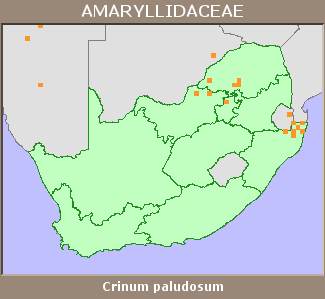Cook, C.D.K. 2004. Aquatic and wetland plants of southern Africa. Backhuys Publishers, Leiden, The Netherlands.
Cunningham, A.B. 1988. An investigation of the herbal medicine trade in Natal/KwaZulu. Investigational Report No. 29. Institute of Natural Resources, Pietermaritzburg.
Raimondo, D., von Staden, L., Foden, W., Victor, J.E., Helme, N.A., Turner, R.C., Kamundi, D.A. and Manyama, P.A. 2009. Red List of South African Plants. Strelitzia 25. South African National Biodiversity Institute, Pretoria.
Sieben, E.J.J. 2009. The status and distribution of vascular plants (Magnoliophyta, Lycophyta, Pteridophyta). In: W.R.T. Darwall, K.G. Smith, D. Tweddle and P. Skelton (eds.), The status and distribution of freshwater biodiversity in southern Africa (pp. 83-98), IUCN and SAIAB, Gland, Switzerland and Grahamstown, South Africa.
Verdoorn, I.C. 1973. The genus Crinum in Southern Africa. Bothalia 11:27-52.
Williams, V.L. 2007. The design of a risk assessment model to determine the impact of the herbal medicine trade on the Witwatersrand on resources of indigenous plant species. Unpublished PhD Thesis, University of the Witwatersrand, Johannesburg.
Zimudzi, C., Archer, R.H., Kwembeya, E.G. and Nordal, I. 2008. Amaryllidaceae. In: J.R. Timberlake and E.S. Martins (eds). Flora Zambesiaca 13 (Part 1):97-134. Royal Botanic Gardens, Kew.
|
 Comment on this assessment
Comment on this assessment

